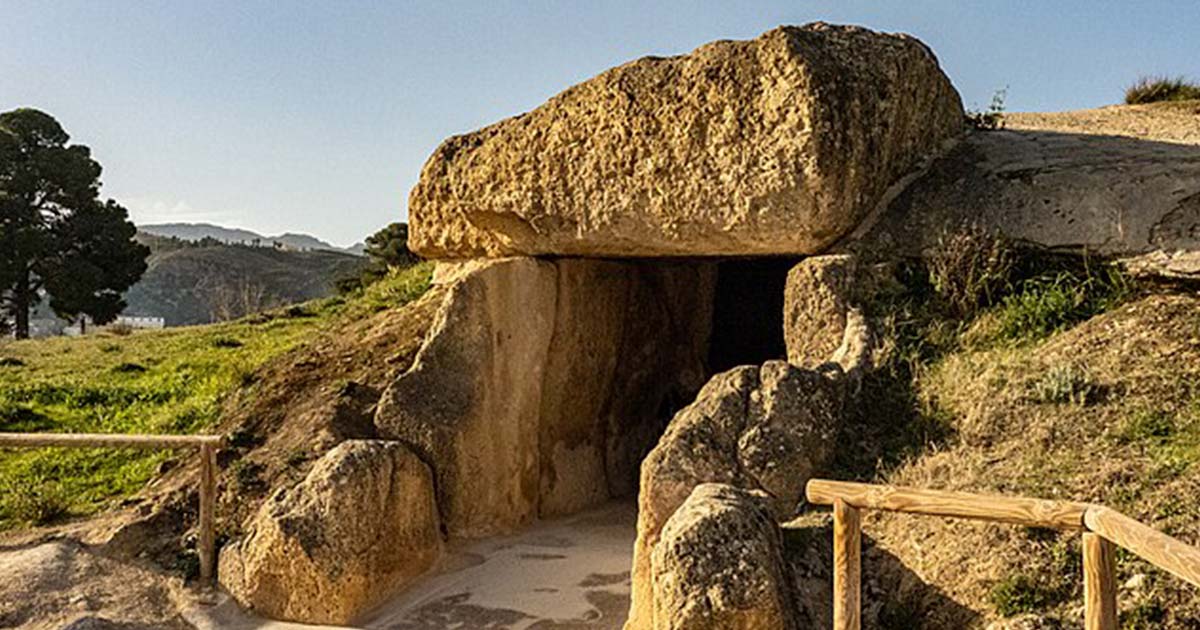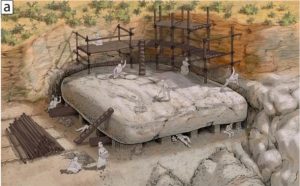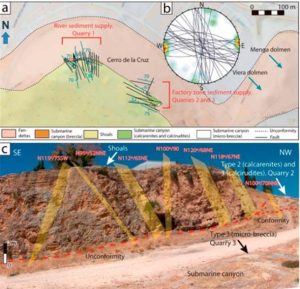Unveiled as “The Greatest Neolithic Engineering Marvel,” Menga Dolmen

A team of archaeologists has deciphered the hidden Neolithic building dynamics within Spain’s 5,700-years-old Menga dolmen. Not only were sophisticated engineering and building methodologies discovered, but the tomb’s alignment with surrounding hills offered visitors an other-worldly light show.
“One of the greatest engineering feats of the Neolithic,” is how the Menga dolmen, in Antequera, Málaga, Spain, is described in a new study published in Scientific Reports. Dated to around 5,700 years ago, and located atop a hill with huge stones, this is the largest known megalithic structure built in what is today, Europe.
The authors, a multidisciplinary team of archaeologists, geologists and historians, have rigorously demonstrated how this ancient burial site was constructed using wood, ropes and cleared tracks.
One of the enormous menhirs within the structure is estimated to weigh more than 100 tons, so some well-planned methodologies were at play. The paper reveals not only how the burial mound was built, but from where the stones were sourced, and how they were transported, undamaged, to the top of the sacred hill.

Artistic representation of quarrying activities for the extraction the capstone C-5 in Cerro de la Cruz Quarry No. 2. (Moisés Bellilty under guidance of José Antonio Lozano Rodríguez and Leonardo García Sanjuán /Nature)
Modern Tech Disclosing Ancient Secrets
The research team discovered that stones around the edges of the burial chamber were assembled in what they call “an interlocking fashion.” It was discovered that this specific design served as a system of water channels to divert, seepage, to prevent erosion and extend the longevity of the tomb. Furthermore, the new research reveals archaeoastronomical considerations in the structure’s orientations, for it was deliberately aligned with nearby mountains, “in a way that creates complex light patterns inside the chamber.”

Interior of the Menga dolmen is 5 meters (16.40 ft) wide and 3 meters (9.84 ft) high, and has a creative design, aligned with mountains. (Angel M. Felicísimo/CC BY 2.0)
The study explains that to better understand the composition of the stones, “petrographic” and “stratigraphic” analysis techniques were applied. The former involves studying rocks under a microscope to identify minerals, assess texture, and understand their formation, while the latter focuses on the arrangement and characteristics of rock layers to decipher the Earth’s chronological history and environmental changes. Essentially, these two analysis techniques reveal the geological processes associated with the evolution of the Earth over time.
Rock-Cut Tombs in Turkey May be Part of Largest Necropolis in the World
Unbelievable Find of Europe’s Largest Megalithic Site In Spain
A Gargantuan Labor Effort Exposed
The results of the petrographic and stratigraphic analysis determined that the stones were mostly calcarenite sedimentary rocks. Categorized by geologists as “soft stones,” they are primarily composed of sand-sized carbonate grains, such as fragments of shells and skeletal debris which form porous and permeable deposits. According to the new research, because this type of rock is relatively fragile, transporting them, undamaged, to the hill top, would have been exceptionally challenging.

A) Geological map of tectonic jointing on DTM, showing the location of Menga and Viera and the likely excavating areas at Cerro de la Cruz. b) Stereographic representation of the groups of joints. c) Overview of the tectonic fracturing present in quarry areas #2 and #3. (Moisés Bellilty under guidance of José Antonio Lozano Rodríguez and Leonardo García Sanjuán /Nature)
The team said “a certain level of engineering sophistication,” must have been present to have organized such “a massive planning and engineering” project. In particular, the paper explains that transporting the roof stone (or capstone) alone would have been particularly difficult. This is because that one stone is estimated to weigh “approximately 150 tons.” Putting this in modern perspective, the Space Shuttle Orbiter, like the Space Shuttle Endeavour, had a liftoff weight of around 100 tons.
Two Megalithic Bronze Age Dolmens Excavated in Southern Spain
Dolmens and Devilish Myths of the Wéris Megaliths, Belgium’s Stonehenge
The Road Ahead
The team tested several models trying to answer how exactly the people moved the huge stones, undamaged, and they derived methods incorporating heavy grass ropes, specialized knots, wooden scaffolds, gravity, and a lot of off-season farmers. However, another very important requirement for the unmarked delivery of the stones was cleared and level roads, or ways.
Many of the world’s monumental landscapes are crisscrossed with long- distance tracks, roads, trade routes and ceremonial ways. There was a moment in time, different from country to country, where farming communities began raising enormous menhirs, vertically, but at the same time they cleared, leveled, and rolled out long-distance roads on the horizontal plane. While ancient roads were used for the transport of stones, in many cases, they also symbolically unified significant spots in the broader landscape, and sky, into their cosmological notions, which they fused onto hill tops with vast stone tombs.